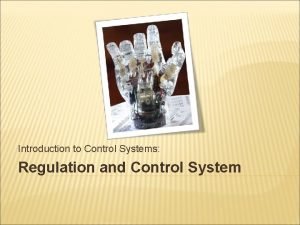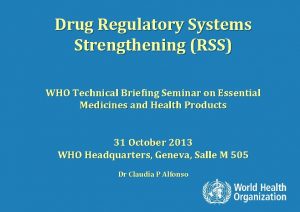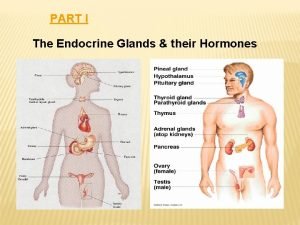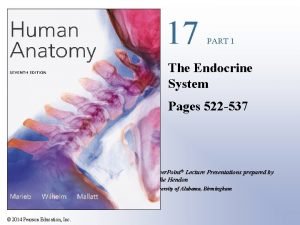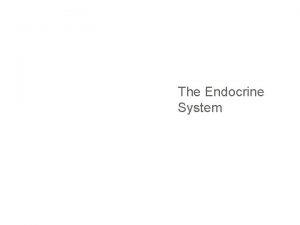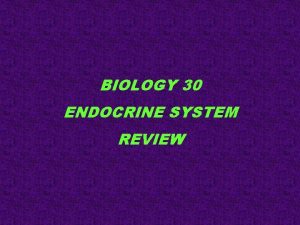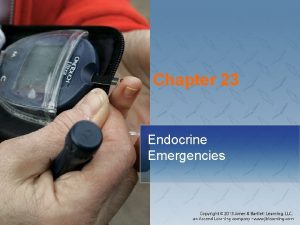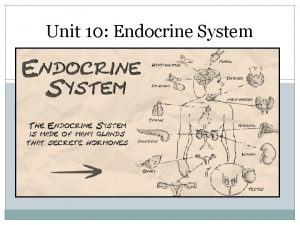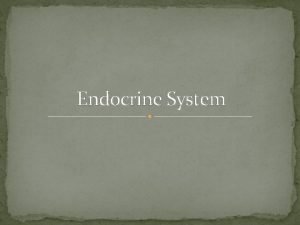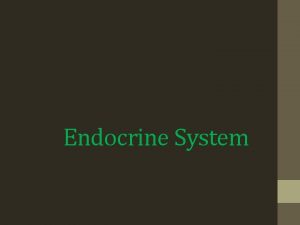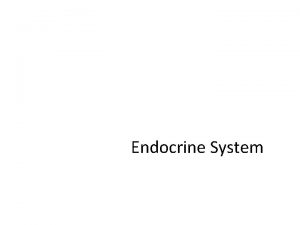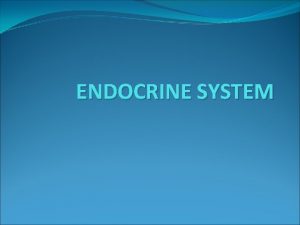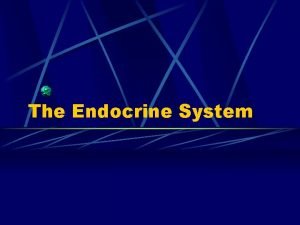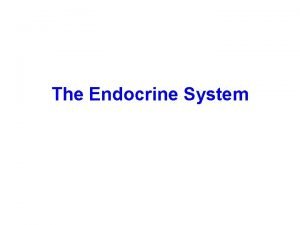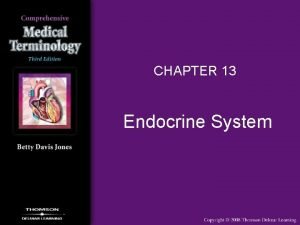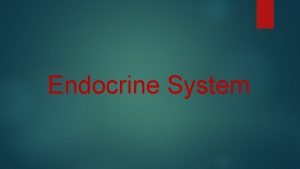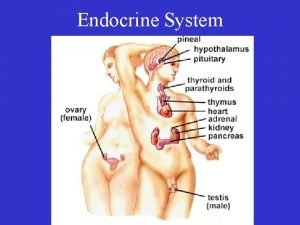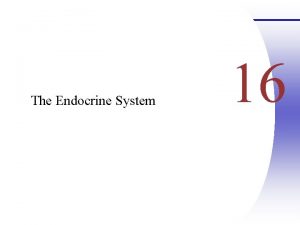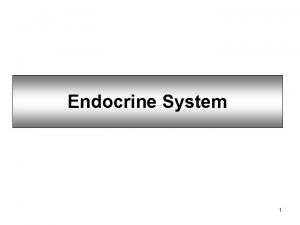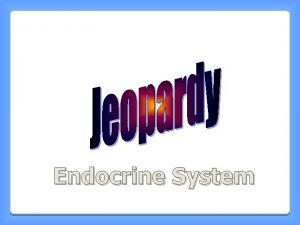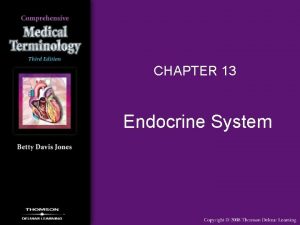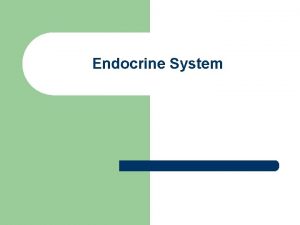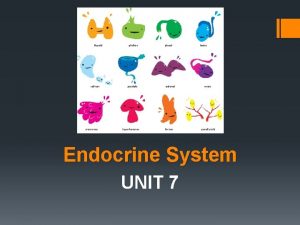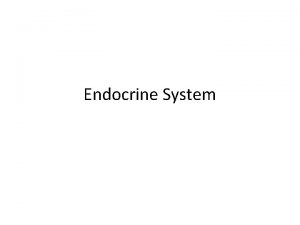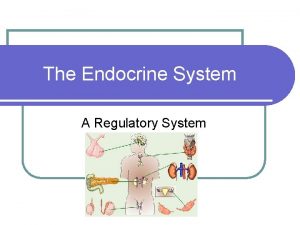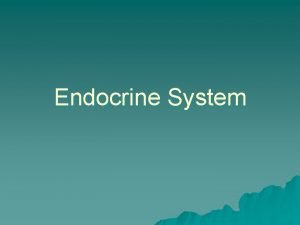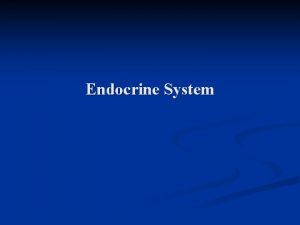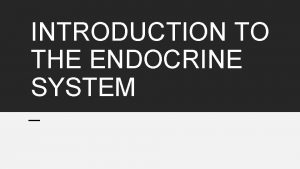The Endocrine System A Regulatory System The Endocrine


























- Slides: 26

The Endocrine System A Regulatory System

The Endocrine System

The Endocrine System HORMONES ACT ON SPECIFIC CELLS

The Endocrine System THE BODY ACTIVITIES ARE COORDINATED l Hormones – substances that are secreted by cells that act to regulate the activity of other cells. l Hormones regulate many processes such as : growth, development, behavior and reproduction.

The Endocrine System THE BODY ACTIVITIES ARE COORDINATED l Endocrine hormones help coordinate the production, use & storage of energy. l Endocrine hormones help allow us to react to stimuli from outside the body.

The Endocrine System To maintain balance is to maintain coordination is to maintain homeostasis… thanks to hormones http: //www. mhhe. com/biosci/genbio/tlw 3/e. Bridge/Chp 27/animations/ch 27/1_glucose_regulation. swf Glucose Regulation

The Endocrine System HORMONES ARE MADE IN CERTAIN ORGANS AND TISSUES l Endocrine Glands – Are ductless glands in the body that release their product(s) directly into blood stream or the extracellular fluid around the outside of cells.

The Endocrine System HORMONES ARE MADE IN CERTAIN ORGANS AND TISSUES l The endocrine system is composed of ductless glands or other related tissues. l These glands produce hormones, which are chemical messengers that are secreted into the bloodstream or into extracellular fluid.

The Endocrine System HORMONES ARE MADE IN CERTAIN ORGANS AND TISSUES l The hormones usually will end up somewhere else in the body. Hormones are used to regulate and coordinate systems of the body.

The Endocrine System Endocrine Disorders Hypo – a disorder where a gland is not secreting enough of a hormone. Hyper – a disorder where a gland is secreting too much of a hormone.

The Endocrine System HORMONES ACT ON SPECIFIC CELLS Amino - Acid Based Hormones – are water-soluble hormone made of amino acids. Steroid Hormones – fat-soluble hormone derived cholesterol. Once hormones are secreted into the blood or extracellular fluid they are transported to a target cell(s) where they will have a desired effect. http: //www. wisc-online. com/objects/index_tj. asp? objid=AP 13704 Actions of Hormones

The Endocrine System HORMONES ACT ON SPECIFIC CELLS Protein based hormones bind to a specific receptor on the cell membrane of the target cell.

The Endocrine System HORMONES ACT ON SPECIFIC CELLS This binding of the hormone and membrane receptor causes a series of internal changes to occur with in the target cell.

The Endocrine System HORMONES ACT ON SPECIFIC CELLS Examples of changes include transcription, exocytosis or endocytosis, membrane channels to open or close. See textbook Page 986

The Endocrine System HORMONES ACT ON SPECIFIC CELLS Steroid hormones are all derived from cholesterol, a lipid. It can diffuse directly through the cell membrane, which is also made up of lipids.

The Endocrine System HORMONES ACT ON SPECIFIC CELLS Steroid hormones usually combine with nuclear membrane receptors. This produces an activated hormonereceptor complex.

The Endocrine System HORMONES ACT ON SPECIFIC CELLS The receptor hormone complex will bind directly to a gene and causing transcription of the gene to occur, leading to the production of a new protein. See textbook Page 980 -981 http: //www. mhhe. com/biosci/genbio/tlw 3/e. Bridge/Chp 27/animations/ch 27/cellular_activity_hormones. swf Cellular activity of Steroid Hormones

The Endocrine System THE RELEASE OF HORMONES MUST BE REGULATED Negative Feedback – mechanism used in homeostasis to keep monitored variable within a certain range. A change in one direction stimulates two control mechanisms to counteract further change in the same direction.

Homeostasis is one of the fundamental characteristics of living things. It refers to the maintenance of the internal environment within tolerable limits. All sorts of factors affect the suitability of our body fluids to sustain life; these include properties like temperature, salinity, acidity, and the concentrations of nutrients and wastes. Because these properties affect the chemical reactions that keep us alive, we have built-in physiological mechanisms to maintain them at desirable levels. When a change occurs in the body, there are two general ways that the body can respond. In negative feedback, the body responds in such a way as to reverse the direction of change. Because this tends to keep things constant, it allows us to maintain homeostasis. On the other hand, positive feedback is also possible. This means that if a change occurs in some variable, the response is to change that variable even more in the same direction. This has a de-stabilizing effect, so it does not result in homeostasis. Positive feedback is used in certain situations where rapid change is desirable. To illustrate the components involved in negative feedback, we can use the example of a driver trying to stay near the speed limit. The desired value of a variable is called the set point. Here, the set point is a speed of 55 mph; in controlling body temperature, the set point would be 98. 6 degrees. The control center is what monitors the variable and compares it with the set point. Here, the control center is the driver; for body temperature, it would be the hypothalamus of the brain. If the variable differs from the set point, the control center uses effectors to reverse the change. Here, the effector is the foot on the accelerator pedal; in controlling body temperature, it would include the glands that sweat and the muscles that shiver.

The Endocrine System

The Endocrine System

The Endocrine System Malfunctions Disease Symptom Goiter Enlargement of the thyroid (red round gland in throat). Diabetes Lack of insulin.

The Endocrine System Nervous System vs. Endocrine Nervous Endocrine Type of Chemical Message Neurotransmitters Hormones Pathway Neuron adjacent to other neuron. Bloodstream Extacellular fluid outside of cell Timing Quick reaction. Slow reaction Short effect not very long lasting Long lasting

Hormone Secreted by Target Tissue Effects Follicle Stimulating Hormone Pituitary Gland Ovaries and Testes Regulates the development of male and female gametes Cortisol Adrenal gland Liver Reaction to long term stress; increases blood glucose levels (energy) Corticotropin releasing hormone (CRH) Pituitary Gland Reaction to stress; tells pituitary gland to release adrenocorticotropic hormone (ACTH) which leads to increased blood glucose Adrenal gland Stimulates the release of cortisol and other steroid hormones from the adrenal cortex – increases blood glucose Pituitary gland Ovaries and Testes Stimulates the release of egg in females; stimulates secretion of sex hormones (testosterone, estrogen and progesterone) Prolactin Pituitary gland Mammary glands Stimulates milk production in breasts Growth Hormone (GH) Pituitary gland All tissues Stimulates protein synthesis and bone and muscle growth Thyroid Stimulating Hormone (TSH) Pituitary gland Thyroid gland Antidiuretic Hormone (ADH) Pituitary gland Kidneys, blood vessels Adrenocorticotropic hormone (ACTH) Luteinizing Hormone (LH) Hypothalamus Pituitary gland Stimulates the synthesis and release of thyroid hormone from the thyroid gland Stimulates reabsorption of water from the kidney; constricts blood vessels

Hormone Secreted by Target Tissue Effects Oxytocin Pituitary gland Mammary glands, uterus Stimulates uterine contractions and milk production Calcitonin Thyroid gland Bone tissue Stimulates calcium to be deposited in bone tissue in order to lower blood calcium levels Bone tissue; kidney Stimulates bone cells to break down and release calcium to blood; stimulates kidneys to reabsorb calcium from urine; activates vitamin D which helps absorb calcium in intestines Liver, muscle Increases blood sugar, increases blood pressure, increases heart rate in response to stress – fight or flight Liver, muscle Decreases blood sugar, decreases blood pressure, decreases heart rate in response to no stress – rest and digest Kindey, sweat glands Retrieves sodium from fluid filtered in kidney (urine); increases volume of blood which increases blood pressure; stimulates kidneys to get rid of potassium Insulin Pancreas (islets of langerhans) Liver Stimulates liver to build glycogen from glucose and helps cells take up glucose decreases blood glucose Glucagon Pancreas (islets of langerhans) Liver Stimulates liver to break down glycogen to glucose increases blood glucose Parathyroid Hormone (PTH) Epinephrine (adrenaline) Norepinephrine (noradrenaline) Aldosterone Parathryroid glands (back of thyroid) Adrenal gland

The Endocrine System Animations http: //www. mhhe. com/biosci/genbio/tlw 3/e. Bridge/Chp 27/animations/ch 27/sodium_and_blood_pressure. swf Sodium and Blood Pressure http: //www. mhhe. com/biosci/esp/2001_gbio/folder_structure/an/m 4/s 2/index. htm Glands and Hormones of the Head and Neck. http: //highered. mcgraw-hill. com/sites/0072437316/student_view 0/chapter 47/animations. html# Steroid Hormone http: //entochem. tamu. edu/G-Protein/index. html (Honors G- Protein Transduction) http: //www. wisc-online. com/objects/index_tj. asp? objid=AP 15004 Gland Overview http: //www. wisc-online. com/objects/index_tj. asp? objid=AP 13804 Stress Responce
 Endocrine system and reproductive system
Endocrine system and reproductive system Endocrine system and nervous system
Endocrine system and nervous system Lympathic
Lympathic Mechanism of action of hormones
Mechanism of action of hormones Endocrine system
Endocrine system Functions of financial system
Functions of financial system Missile launcher control system
Missile launcher control system Regulatory system strengthening
Regulatory system strengthening Regulatory system strengthening
Regulatory system strengthening Chapter 16 matching questions 1-5
Chapter 16 matching questions 1-5 Parts of the endocrine system
Parts of the endocrine system Differences between nervous system and endocrine
Differences between nervous system and endocrine Comparison of endocrine and nervous system
Comparison of endocrine and nervous system Steroids endocrine system
Steroids endocrine system Facts about the endocrine system
Facts about the endocrine system Rat appendix
Rat appendix Tropic hormones hypothalamus
Tropic hormones hypothalamus Pearson
Pearson Endocrine and nervous system comparison
Endocrine and nervous system comparison Chapter 7 13 endocrine system
Chapter 7 13 endocrine system Mammillary body
Mammillary body Figure of endocrine system
Figure of endocrine system Endocrine glands
Endocrine glands Biology 30 endocrine system
Biology 30 endocrine system Site:slidetodoc.com
Site:slidetodoc.com Pituitary
Pituitary Endocrine system analogy
Endocrine system analogy






